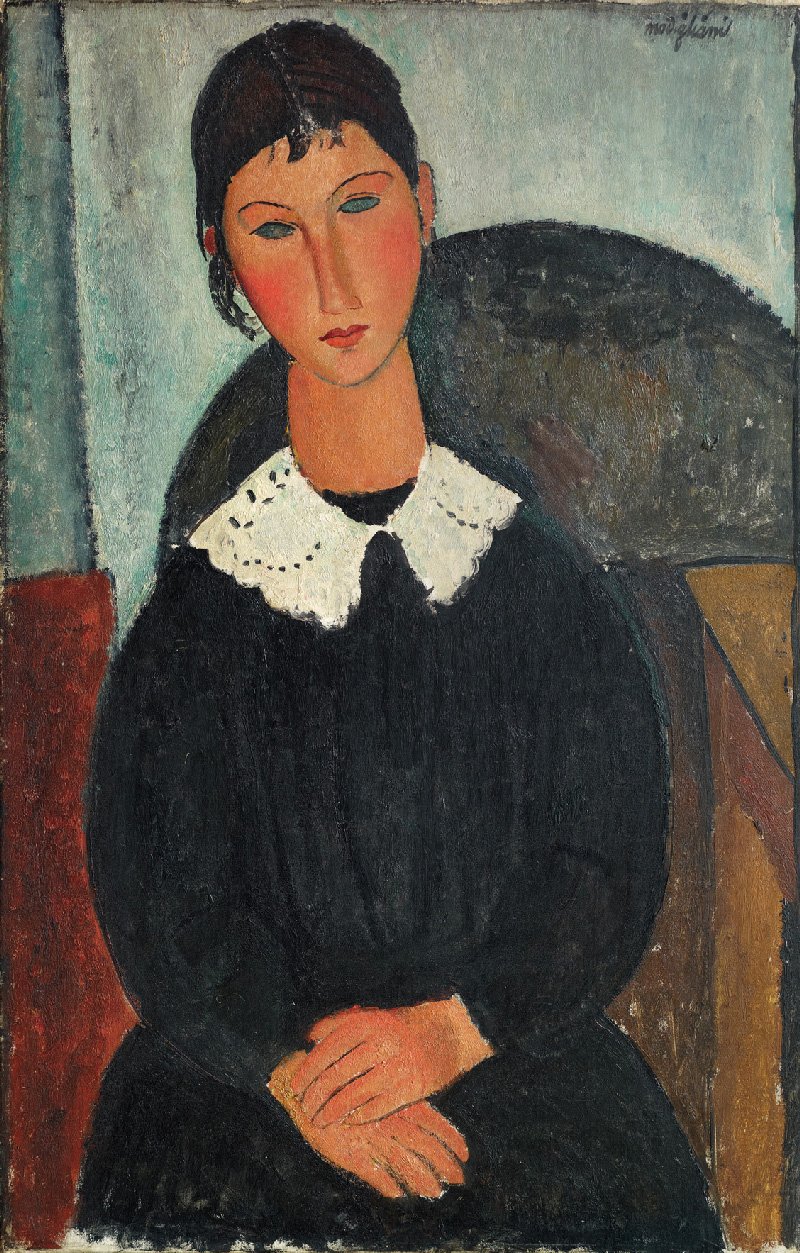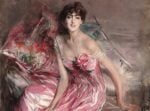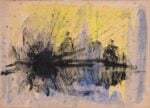Modigliani Soutine e gli artisti maledetti

Più di 120 le opere in mostra per ricostruire il percorso di questi artisti che vissero in un periodo affascinante della storia dell’arte nel quartiere di Montparnasse agli inizi del ‘900: Modigliani, Soutine, Utrillo, Suzanne Valadon, Kisling e molti altri.
Comunicato stampa
'Queste opere non sono state mostrate al pubblico da più di settant’anni, e oggi ricompaiono come per magia, come uscite da un altro mondo'.
Con queste parole Marc Restellini, curatore della mostra 'Modigliani, Soutine e gli artisti maledetti. La collezione Netter' dà il senso all’esposizione che si apre il 14 novembre 2013 nelle sale del Museo della Fondazione Roma, promossa da Fondazione Roma, Comune di Milano, Palazzo Reale, Soprintendenza per il Patrimonio Storico, Artistico ed Etnoantropologico e del Polo Museale della Città di Roma e prodotta e organizzata da Arthemisia Group in collaborazione con la Pinacothéque de Paris.
Più di 120 le opere in mostra per ricostruire il percorso di questi artisti che vissero in un periodo affascinante della storia dell’arte nel quartiere di Montparnasse agli inizi del ‘900: Modigliani, Soutine, Utrillo, Suzanne Valadon, Kisling e molti altri.
Modigliani era sbarcato a Parigi nel 1906 sentendo che quello era il posto dove avrebbe potuto 'salvare il suo sogno'. Va a vivere a Montparnasse che, in quegli anni, diventa il quartiere degli artisti; non solo pittori, ma anche scrittori, come Hemingway e Miller, intellettuali come Jarry e Cocteau, rifugiati politici come Lenin e Trockij.
I luoghi di incontro sono le trattorie a buon mercato e le bettole-cantine in cui si tira tardi parlando di arte e politica e non di rado le discussioni terminano in risse. Le condizioni di vita sono per tutti assai misere, ma è il fuoco sacro dell’arte, la consapevolezza che le loro opere stanno cambiando per sempre i canoni estetici, a dare la forza a Modigliani e compagni di andare avanti.
Se l’Impressionismo, pur avendo apportato una rivoluzione nel modo di dipingere, non usciva in fondo dai canoni del naturalismo, con i lavori di Modigliani, di Soutine, di Utrillo, l’arte diventa autonoma dal soggetto ritratto e dalle tradizioni culturali e artistiche dei paesi di provenienza dei singoli artisti, generando la prima vera rivoluzione nel mondo dell’arte e il ribaltamento dei canoni sino ad allora conosciuti. È in questo contesto - che di lì a poco verrà definito bohémien - che, come scrive il curatore Marc Restellini: 'Questi spiriti tormentati si esprimono in una pittura che si nutre di disperazione. In definitiva, la loro arte non è polacca, bulgara, russa, italiana o francese, ma assolutamente originale; semplicemente, è a Parigi che tutti hanno trovato i mezzi espressivi che meglio traducevano la visione, la sensualità e i sogni propri a ciascuno di loro'.
E ancora: 'Quegli anni corrispondono a un periodo d’emancipazione e di fermento che ha pochi eguali nella storia dell’arte. Ovunque in Europa era in corso una rivoluzione estetica, preludio a un’evoluzione dei costumi; ed è a Parigi, ‘l’unico luogo al mondo in cui la rivolta ha il diritto di cittadinanza’, prima a Montmartre e poi a Montparnasse, che quegli artisti – tutti ebrei – si sono ritrovati per tentare la sorte'. Ed ebreo era anche Jonas Netter, una figura importantissima per gli artisti in mostra, senza il quale molti tra loro non avrebbero avuto di che vivere e sostentarsi: il percorso espositivo, articolato in sei sezioni, mette a confronto i capolavori acquistati nell’arco della sua vita da Jonas Netter, che, affascinato dall’arte e dalla pittura, diventa un amateur illuminato e acuto riconoscitore di talenti, grazie all’incontro col mercante d’arte e poeta polacco Léopold Zborowski, anche egli ebreo.
Netter conosce Modigliani, Soutine, Utrillo ed entra in contatto con Valadon, Kisling, Krémègne, Kikoïne, Hayden, Ébiche, Antcher e Fournier. La loro produzione lo affascina e lo spinge a sostenerli generosamente e a comprare dal mercante i loro lavori: egli diventa quasi un “mecenate”, ispirato e geniale insieme tanto che, quando Modigliani è costretto a trasferirsi in Costa Azzurra a causa di problemi di salute, compra dal giovane italiano abbastanza tele da permettergli di affrontare il viaggio, durante il quale poi l’artista lavorerà intensamente. Di Modigliani Netter ammira l’originalità del genio creativo, ama profondamente i suoi volti femminili stilizzati su lunghi colli affusolati, come Elvire au col blanc (Elvire à la collerette) del 1917-18 e Fillette en robe jaune (Portrait de jeune femme à la collerette) del 1917, entrambi esposti insieme a Portrait de Zborowski del 1916 e Portrait de Soutine, anch’esso realizzato nel 1916 dopo l’incontro tra i due artisti che stringono una solida amicizia, al punto che è proprio Modigliani a presentare a Netter Soutine. Di Chaim Soutine sono esposti in mostra oltre venti olii – una vera e propria mostra dentro la mostra – tra cui L’Homme au chapeau, L’Escalier rouge à Cagnes e La Folle.
Allo stesso modo Netter scopre i quadri del cosiddetto periodo bianco di Utrillo, soprattutto vedute, tra le quali in mostra Place de l'église à Montmagny, Église de banlieu e Rue Muller à Montmartre. Netter decide di proteggere questo eterno fanciullo disincantato, preda sin dall’adolescenza dei fumi dell’alcool, innamorato della madre, Suzanne Valadon, valente e originale pittrice, anche ella presente con le sue opere in mostra, come Ketty nue s'étirant o Église de Neyron.
Se oggi noi ammiriamo questi lavori come capolavori assoluti dell’arte, non dobbiamo dimenticare tuttavia che all’epoca in cui videro la luce venivano considerati veri e propri obbrobri. È per questo che l’intuizione di Netter appare una vera e propria profezia, oltre che un atto coraggioso e spesso disinteressato. Poco si sapeva di quest’uomo tale era la sua discrezione. Oggi, grazie al lavoro di ricostruzione di Restellini, possiamo farci un’idea del suo volto grazie al ritratto che gli fece, riconosciuto da vecchie fotografie familiari, Kisling, anch’esso in mostra.
E la leggenda vuole che sia stato proprio Modigliani a presentare Kisling a Netter. A causa del suo atteggiamento così discreto, di Jonas Netter non rimane nulla di personale. Tranne le opere che amò e collezionò e che anche noi oggi possiamo contemplare.
In 2010 the Fondazione Roma and the Milan Municipality shared a great success: the
“Edward Hopper” exhibition, organised at the Palazzo Reale in Milano and subsequently at
the Museo della Fondazione Roma and featuring an amazing coincidence in the number of
visitors: 208.400 in Milan, 209.200 in Rome. A few years on, and once again with Arthemisia
Group, this fortunate partnership – enhanced by the participation of the Special Department
for Rome Museums – is revived thanks to a new significant exhibition: “Modigliani, Soutine
e gli artisti maledetti”, over 100 magnificent works produced in Paris during the Golden
Years, during that magical twenty-year period at the beginning of the XX° century when all
major artists would convene in Paris cafés to discuss and fight over art.
Modern Art was born there, at that time and along those streets: Modigliani, Picasso, Braque,
Gauguin, Chagall, Kandinsky and many others: a unique creative excitement, a short circuit
that spawned life and timeless masterpieces. Montparnasse becomes the artists district,
dominated by the so-called artistes maudit: Soutine “the filthy”, Valadon and Utrillo “the
incestuous”, Vlaminck, Hayden, Solà, Kisling and the most charismatic of all, the handsome
and damned Italian, the excessive, passionate and self-destructive Amedeo Modigliani. They
all experienced desperate lives and tragic destinies, but each of them found their own way to
silence the cry of their souls.
Each artist paints in their own way, but they share the same vibes. And they are still strong.
Someone else was also roaming the streets of Paris, Jonas Netter, an affluent merchant who
develops a liking for the lives and works of the talented, broke artists. He pays for their food
and accommodation, and more often than not he saves their lives: in return, he is given their
paintings: he becomes so fond of them that he never wants to part from them. Netter ignored
that one day these paintings, handed to him in return for a bowl of hot soup, would be worth a
fortune. The story of the famed Netter Collection begins here. This collection had been
inaccessible up until a few years ago, when the family decided to set up a Foundation
targeted at helping out the needy, today as it did back then. The Museo della Fondazione
Roma offers a great opportunity to be overwhelmed by the amazing beauty and strength of
artistes maudit.
The Fondazione Roma, led by the forward-looking President Emmanuele F. M. Emanuele,
who was so generous as to welcome the show in the recently renovated Museo di Palazzo
Cipolla, promotes the exhibition. Other sponsors include the Milan Municipality -Palazzo
Reale under the Department for Culture led by Filippo Dal Corno and the accurate Direction
of Domenico Piraina, as well as the Special Department for PSAE and Museums of the
city of Rome, chaired by the Supervisor Daniela Porro.
Production and organisation are by Arthemisia Group, which has produced the exhibition in
cooperation with the Pinacothèque de Paris and with the contribution from 24 ORE Cultura
- Gruppo 24 ORE.
Over 100 works on display to reconstruct the path followed by those artists, who lived in a
fascinating time for the history of art in the Montparnasse district at the beginning of the XX°
century. Modigliani arrives in Paris in 1906, convinced that that is the place where he will be
able to “save his dream”. He settles down in Montparnasse which, in those years, becomes
the art district, not just for painters, but also for writers, such as Hemingway and Miller,
intellectuals like Jarry and Cocteau, political refugees like Lenin and Trockij.
The artistsʼ meeting points are cheap taverns and joints-cellars, where artists discuss art and
politics until the small hours and where discussions very often turn into fights. Life conditions
are very wretched for everybody, but Modigliani and his comrades find the strength to go on in
the sacred fire of art, the awareness that their work is changing aesthetic rules forever.
If Impressionism, despite having introduced a revolution in the way artists painted, in the end
did not break free from the rules of naturalism, with the works of Modigliani, Soutine, Utrillo,
art becomes detached from the portrayed subject as well as from the cultural and artistic
traditions of the individual artistsʼ countries of origin, thus generating the first true revolution in
the art world and turning upside downs all the rules and standard used until then.
This is the context – soon to be defined bohémien - where, as the curator Marc Restellini
writes: “These troubled souls express themselves in a painting fed by desperation. At the end
of the day, their art is not Polish, Bulgarian, Russian, Italian or French, but rather absolutely
original; to put it simply, it is in Paris that they all discover the means of expression that could
better translate their own personal vision, sensuality and dreams”.
And again: “Those years feature a time of emancipation and unrest that has remained nearly
unique in the history of art. Everywhere in Europe an aesthetic revolution was under way, a
prelude to a revolution of behaviours; and it is in Paris, ‘the only place in the world where
insurrection is granted the right of citizenship ’, in Montmartre before and in Montparnasse
later, that those artists – all Jews – met to take their chances”.
Jonas Netter was also a Jew, a very important figure for the artists on display in the exhibition;
without him many of them wouldnʼt have had anything to live on: the exhibition itinerary,
subdivided in six sections, features the masterpieces acquired by Jonas Netter during his life;
this man, fascinated by art and painting, turns into an enlightened amateur and a sharp talent
detector, thanks to his meeting with the Polish art dealer and poet Léopold Zborowski, himself
a Jew.
Netter meets Modigliani, Soutine, Utrillo and has a connection with Valadon, Kisling,
Krémègne, Kikoïne, Hayden, Ébiche, Antcher and Fournier. Their production fascinates him
and prompts him to support them generously and to purchase their works from the art dealer:
he becomes a sort of would-be “patron”, both inspired and a genius. So much so that when
Modigliani is forced to move to the French Riviera for health-related problems, he purchases
from the young Italian as many paintings as needed to pay for his stay, during which the artist
then works very hard.
Netter is a great admirer of Modiglianiʼs creative genius, he deeply appreciates his sketched
female faces resting on long thin necks, such as Elvire au col blanc (Elvire à la collerette)
from 1917-18 and Fillette en robe jaune (Portrait de jeune femme à la collerette) from 1917,
both exhibited together with Portrait de Zborowski (1916) and Portrait de Soutine, also painted
in 1916 following the meeting of the two artists, who started a long-lasting friendship, so much
so that Modigliani introduced Soutine to Netter. The show features over twenty oil paintings by
Chaim Soutine – a true exhibition-in-the-exhibition – including L’Homme au chapeau,
L’Escalier rouge à Cagnes and La Folle. Similarly, Netter discovers the paintings belonging to
Utrilloʼs so-called white period, especially landscapes; the exhibition features Place de l'église
à Montmagny, Église de banlieu and Rue Muller à Montmartre. Netter decides to act as a
guardian of this eternally disillusioned child, a very young victim of alcohol, in love with his
mother, Suzanne Valadon, a talented and original painter, whose work is also on display,
including Ketty nue s'étirant or Église de Neyron.
If on the one hand we are currently great admirers of these works as absolute art
masterpieces, on the other hand it is worth remembering that at the time when they were
produced they were considered true monstrosities. This is the reason why Netterʼs intuition
resembles a true prophecy, besides being a brave and often unselfish gesture. Not much was
known about this man, such was his discretion and reserve. Today, thanks to Restelliniʼs
reconstruction work, we can visualise his face in the portrait by Kisling, which has been
recognised in old family photographs – the portrait is also on display.
And the story goes that it was Modigliani himself who introduced Kisling to Netter. Because of
Netterʼs reserved attitude, none of his personal belongings survivedhim, except for the works
he loved and collected and which we have a chance to admire today.



